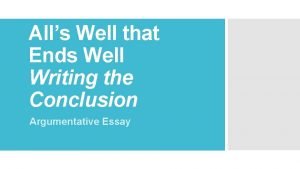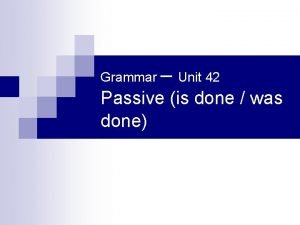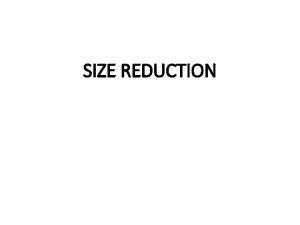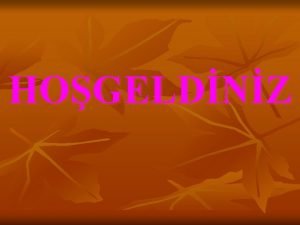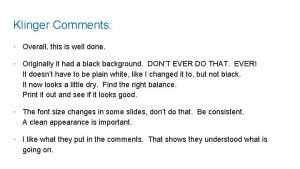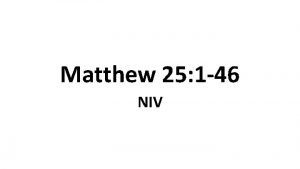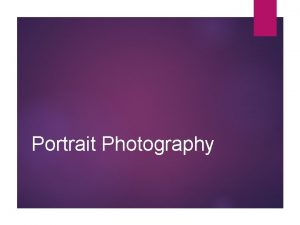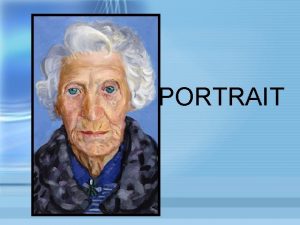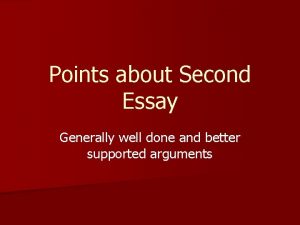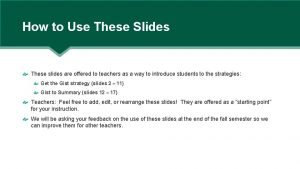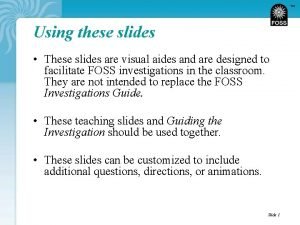S 34 Portrait Essay Well done These slides











- Slides: 11

S 3/4 Portrait Essay Well done! These slides will help you complete your Portrait Essay. Have your essay in front of you. Use the help sheets to add extra bits to your essay. Write out the extra bits to add to your essay on paper or save on a pen-drive and bring to class. Then they can be added to the electronic copy of your essay once looked at by your teacher. Your essay must be finished for the 23 rd December 2010 How to use the slides Slide 2 - follow each of the 10 steps to make sure you have written about every area you need to. Slide 3 - Look at how to write a good thought you have in a clear sentence. Slides 4, 5, 6 - Questions to ask yourself when looking at the portraits you have chosen. There is a different section for each of the visual elements. For a successful essay you must write about each of the visual elements. Go through each question and if you have not answered the question in you essay already then answer it. Slides 7, 8, 9 - Here are lots of describing words and Artist’s vocabulary. Put these words in your sentences. There is a different word bank of each of the visual elements. Look at the workbank for ‘Line’ when thinking about the questions for ‘Line’, for example. Slide 10 - Here’s a writing frame to start you off when writing about the artwork.

How to write an Expressive Essay in 10 steps 1. Write an introduction stating what you will write about. Include Artist’s names and specific titles of artwork. 2. State which artist and artwork you will write about first. 3. Describe first artwork in detail. 4. Describe everything you see. 5. Say what you see and what it tells the viewer specifically about the subject. 6. Use the question sheets. Ask yourself each question and use work bank to add lots of describing words. 7. Find another piece of artwork by the same artist. Compare and contrast both artworks. 8. Repeat steps 2 -7. 9. Compare and contrast both artists’ styles, subject matter and how they use the visual elements. 10. Say which artist or artwork you prefer and why. Due Date – 23 rd December 2010

The use of Visual Elements/ Write about each of the visual elements; Line, Form, Texture, Colour, Tone, Shape, Pattern. Describe a specific part of the artwork. Describe which visual element you will be writing about. Use lots of describing words (see word banks). Describe effect of visual element on – • Another visual element. • The person in the portrait and what it tells us about them. • The composition and how it makes an area stand out. Is contrast created? Describing Words For example. . ‘The artist’s use of colour is important. The cold, pale blues, greys and silvers used create a sad mood. ‘ Visual Element Effect of visual element

Expressive Essay/How to start State the Artist and title of the portrait you will be writing about. Describe the portrait in full; say what you see as if describing it to someone who can’t see it. Describe the Fore-ground, Mid-ground and background. Describe the subject. If you met the person in portrait describe what you think their personality would be like. The artist will use the Visual elements and composition to make the most interesting picture they can. For the best marks you must write about – The person in the portrait and how the artist tells us about their personality. How the visual elements have been used and how they affect each other, the composition and the subject. Your opinion on the artwork and reasons why you like and don’t like specific parts of it. Composition This is where the artist has positioned everything in the artwork to – • Make you look at it; draw the viewer’s eye around the painting and to the focal point. • Create balance and harmony to the whole space of the artwork. • Imagine you had to draw out the artwork in the simplest shapes and lines. To do. . Identify the basic shapes which make up the painting. Look for things which are lined up like a cross, a triangle or circle. Does the shape make any area stand out or bring different parts together or point to anything? Imagine the painting is a see-saw. Has the artist balanced the painting with different things in different areas? People have been shown to like things split into thirds. Has the artist split up the artwork into thirds? Say what you see in each third.

The use of Visual Elements/ Questions to ask yourself. Use word bank to help you with each visual element Line Describe what lines can be seen in the portrait. How have the lines been created? Have a lot of lines been used? Do the lines create basic shapes? Do the lines point to anything or make something stand out? Do the lines make basic shapes or make the composition stronger? How does the use of line affect the composition of the portrait? How does the use of line affect the balance of the portrait? Form Has the artist made things look 3 -D or flat? Describe how the artist has made something look 3 -D or flat; refer to using tone (light and dark). Are the forms realistic? How are the forms different from real life? Describe how the forms are positioned; refer to composition How do the forms fill the space? Texture Write about how different things in the artwork feel. Look for contrasts of texture and describe them. Describe how you think the surface of the artwork would feel. How has the paint or materials been applied to the surface?

The use of Visual Elements/ Questions to ask yourself. Use word bank to help you with each visual element Colour Use describing words to say what sort of colours you see. Are there colours which go well together? Give reasons. Are there contrasting colours? Are there warm or cool colours? How do the colours create a mood or feeling to the artwork? How do the colours link to what is in the artwork and it’s theme. Tone What sort of light is in the artwork (natural, Man-Made, low light, bright)? Where is the light coming from? What is lit up and emphasised? What is dark, in shadow and hidden? How does the use of light and dark tell us about the subject and their personality? Shape Describe the sort of shapes you see. Are there a lot of one sort of shape in different parts of the artwork? Are there contrasting shapes? How do the shapes fit together? How does the position of the shapes affect the composition?

Critical/Art Studies/Word Bank Name/Class Circle the works you use when responding to an artwork Art Studies Vocabulary The Artist Artwork Title Materials Portrait Self-Portrait Landscape Technique Processes Perspective Style Background Space Communicates Perspective Narrative Contrasting Gaze Dimensional Surrounding Interior Exterior The Viewer The Subject Figure Composition Influence Important Middle-ground Viewpoint Stand out Parts Object Weather Atmosphere The Subject Matter Still-Life Theme(s) Focal Point Represents Transform Study Symbol Foreground Composition Influenced Emphasize Story Personality Two Dimensional Three Engaged Experimented add other words you use. . Image Realistic Simplified Flat Monumental Small Decorative Real Unreal Challenging Extreme Skilful Detailed Intimate Dreamlike Skill Classic Artificial Layered Life-size Romantic Scientific Modern Accurate Hidden Powerful Abstract Tilted Stark Contemporary Slanted add other words you use. . Composition Focal Point Balanced Balance Horizontal Ordered Depth Basic Harmony Unity Chaotic Strong Symmetrical Asymmetric Cluttered Busy Arrangement Diagonal Clear Upward Downward Cross Line Shape ‘Drawing the viewer/the eye in’ Angle Vertical Vanishing Point Close Distant Noisy Direction add other words you use. . Mood Feeling Happy Chaotic Tranquil Distressing Feelings Sad Dramatic Powerful add other words you use. . Emotion Funny Quiet Energetic Angry Energy Scary Tense Busy Upset Force Mysterious Tension Sinister Worried Serene Turbulent Relaxed Friendly Exciting Dark Personalities Quiet Sunny Relationship Moody Tense Melancholic

Critical/Art Studies/Word Bank Circle the works you use when responding to an artwork The Visual Elements are used by artists to create eye-catching artwork. They may use all the visual elements in an artwork or focus on using a few or even one. The 7 Visual Elements are – Line, Form, Tone, Colour, Texture, Shape, Pattern Line Drawing Sketching Expressive Moving Flowing Linear Broken Organic Geometric Three Dimensional Flat Jagged Slashed Crude Broad Curved Sinuous Dancing Controlled Hard Gentle Sweeping Heavy Depth Delicate Formless Solid Structure Forms Bold Shadow Emphasised Jutting Formlessness Carved Cast Moulded Quiet Fore- Shades Funny Reflective Summer Sunny Rendering Scary Tint Day Shiny Rendered Natural Mysterious Friendly Reflecting Golden Night Flash Silhouette Moody Morning Energetic Warm Sombre Mixed Opaque Unnatural Sad Cold Bright Bold Explosion Muted Plain Vivid Quiet Spontaneous Lush Intense Washes Complimentary Limited Eye-catching Earthy Solid Blocks Monochrome Splash Soft Wandering Elongated Light Simplified Outline Slow Fluid Subtle Fast Defining Strong Chaotic Restrained Detailed Defined Restrained Order Sensitive add other words you use. . Form (3 -D Shape) Tonal Light source Direction Plain Heavy Light shortening Shapeless Hazy add other words you use. . Tone Light Source Harsh Chaotic Exciting Busy Light Happy Dramatic Quiet Sinister Dark Sad Quiet Tense Dark Electric Evening Powerful Hint add other words you use. . Colour Palette Wild Exotic Muddy Harmonious Clashing Rich Primary Secondary Tertiary Unconventional Strong Vibrant Volume Expressive Contrasting Translucent Luminous Natural Subtle Happy Angry add other words you use. .

Critical/Art Studies/Word Bank Circle the works you use when responding to an artwork The Visual Elements are used by artists to create eye-catching artwork. They may use all the visual elements in an artwork or focus on using a few or even one. The 7 Visual Elements are – Line, Form, Tone, Colour, Texture, Shape, Pattern Texture Materials Impasto Exposed Melted Textured Touch ‘Worked into’ Flakey Brushstrokes Movement Surface Uneven Built Up Action Jagged Mixed Expressive Painterly Smooth Dry Wet Brittle Reflective Distressed Scraped Sensation Wavy Organic Sharp Smooth Cluttered Abstract Distorted Pronounced Detailed Jutting Hollow Beauty Ornate Explosion Style Light Lines Swirling Hypnotic Dazzling Across Minimal Monumental Overwhelming Expression Scumbled Rough Cracked Layer Warped Runny Trickled add other words you use. . Shape Figure Geometric Curved Rounded Basic Jagged Cubist add other words you use. . Pattern Repetition Heavy Rhythm Dotted Decoration Embellished Symmetry Sequence Expressive Brushed Splattered Detail Eye-catching Stripes Dabs Fine Elaborate add other words you use. . Scale/Size Proportions Natural Focus Powerful Fat add other words you use. . Proportioned Life-Size Minute Huge Massive Bulky Slim Immense Spreading

Critical/Art Studies/Writing Frame Use these phrases to start sentences or clearly say what you mean. The painting shows. . In the painting. . We can see. . This reflects. . The use of. . The artist has focused on. . This affects. . This emphasises. . That makes…. stand out. The eye is drawn to. . There is a contrast between. . This influences. . This creates a sense of. I feel. . In my opinion. . In conclusion. .

What the portrait tells us Subject Use of Visual elements Responding to a Lines Portrait Personality Form (3 -D Shape)/Shape Expression Texture Pose/Gaze Colour Mood Clothes/Costume/Symbols ‘Self Portrait With Stetson’ By John Byrne (Scottish, born 1940) Oil on canvas 1989 90 x 70 cm Tone (light and Dark) Composition
 Opinion writing conclusions
Opinion writing conclusions Unit 42 passive 1 is done was done answer
Unit 42 passive 1 is done was done answer Cutter mill principle
Cutter mill principle Sen bir koyun olsan bende bir kuzu sözleri
Sen bir koyun olsan bende bir kuzu sözleri A small child slides down the four frictionless slides
A small child slides down the four frictionless slides Energy of four forces quick check
Energy of four forces quick check Jwd consulting case study
Jwd consulting case study Well done and thank you
Well done and thank you You done well
You done well Well done children
Well done children Overall well done
Overall well done Matthew 25 14-30 niv
Matthew 25 14-30 niv
